High-dynamic-range – HDR – is an image-processing technique that's been gaining popularity over the last few years. HDR can be used to create some amazing, impactful, stunning images. For some eye-popping examples, see this page, which is just one page of many that are linked from this HDR roundup.
I haven't created anything amazing with HDR, but I utilized HDR in whipping this image together, just for this post...
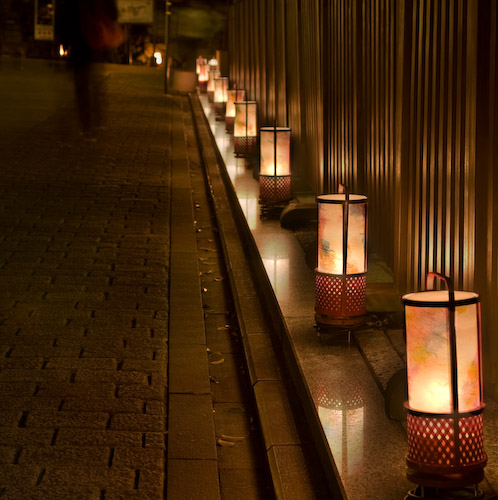
Nikon D200 + Nikkor 17-55/2.8 @ 34 mm — HDR, f/3.5 — map & image data — nearby photos
HDR Example
boring, but illustrative
HDR attempts to overcome a limitation of current camera technology... a limitation that disallows a camera from picking up fine detail in the dark shadows and bright highlights of a scene at the same time. This limitation can be easily seen in the main source photo used in creating the image above, a two-second exposure that I took during the Kyoto Higashiyama “Hanatoro” Lightup Event in March:
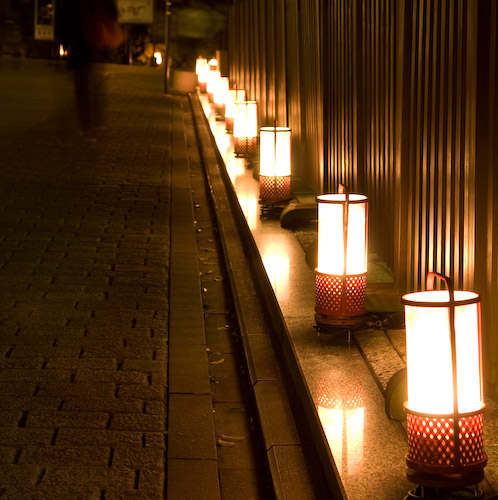
Nikon D200 + Nikkor 17-55/2.8 @ 34 mm — 2 sec, f/3.5, ISO 100 — map & image data — nearby photos
Original Photo
Exposed to bring out detail in the street and other darker areas,
with the unfortunate side effect that the lanterns are “blown out”
As you can see here, the lanterns appear to be just big blobs of white. They weren't big blobs of white, of course (they were a delicate pattern of fine colors, and looked like this), but with the limitations of my camera's image sensor, if I left the shutter open long enough for a reasonable capture of the dark street, the relative firehose of photons from the much brighter lanterns simply overwhelm the sensor in that part of the photo. With my camera's sensor, as with virtually all digital cameras today, “overwhelm” means “registers as pure white.”
On the other hand, if I use a shorter exposure – one that slams the door shut on the photon firehose before the image of the lanterns is totally blown out – the detail in the lanterns is retained, but now the unfortunate side effect is that the dark areas of the scene don't have a chance to send enough photons, and they end up black. Here's the same scene, but with a much shorter exposure that allowed only 1.7% as much light in as above...
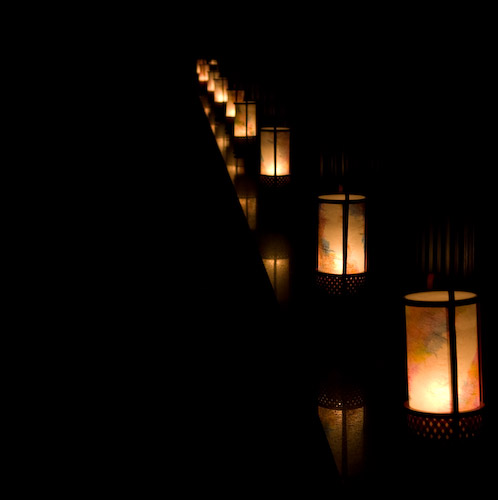
Nikon D200 + Nikkor 17-55/2.8 @ 34 mm — 1/30 sec, f/3.5, ISO 100 — map & image data — nearby photos
Shorter Exposure
Detail now mostly retained in the lanterns, but lost everywhere else
In this particular situation, my eyes didn't have a problem capturing detail in all areas of the scene at once, but like our cameras, our eyes do suffer from this issue to some extent (try reading the label on the end of a 100w bulb while it's lit and you'll have a difficult time of it). Still, camera technology is far behind God in this respect, and that's where HDR comes in.
To create the shot seen at the top of this post, I brought in lantern detail from the “shorter exposure” image, as well as from another intermediate image, and blended it all in where the original was blown out. For having spent just a few minutes on it (and without much HDR experience to begin with), the technical result in this case is surprisingly good – the result looks completely natural – although the effort seems to be a waste of energy on such a boring scene.
Here again is the HDR version, and the three photos used to make it; mouseover the buttons below the image to see each version...

Nikon D200 + Nikkor 17-55/2.8 @ 34 mm — 2 sec, f/3.5, ISO 100
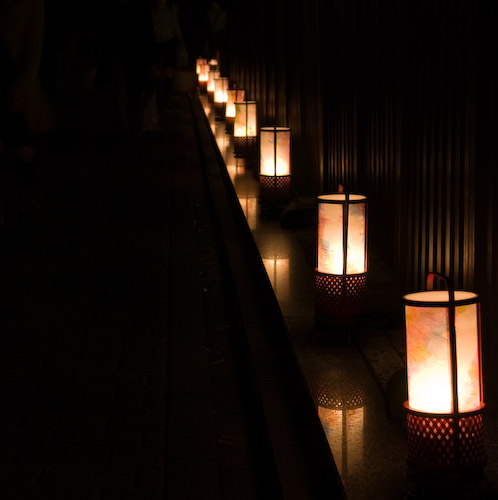
Nikon D200 + Nikkor 17-55/2.8 @ 34 mm — 1/10 sec, f/3.5, ISO 100

Nikon D200 + Nikkor 17-55/2.8 @ 34 mm — 1/30 sec, f/3.5, ISO 100
On rare occasions I do this kind of specific “filling in the details” processing, pulling in sections from other exposures of the same scene. I did it when I created the large image of one lantern (here), and perhaps I've done it one or two other times.
Somewhat similarly, at times I've “painted” in color that was lost due to the aforementioned “blown out” problem. I did it with the sky of this picture, and the blue lights in the side areas of this photo. The center section actually had white lights mixed in as you see there, but the sides were pure, retina-burning blue. Unfortunately, in the original, the brightest parts of the blue lights came out pure white, just like in this unfixed photo, so I painted back some blue.
All this so far shares a lot of DNA with HDR, but it's probably not what most people would consider true HDR. To look at that, we first need to understand...
The Problem with HDR
Here's a “real” HDR image I whipped up just for this post, using two photos I took of our room at a seaside ryokan in Ise, Japan, a year and a half ago, showing detail in both the brilliantly bright outside, and the much-darker inside...
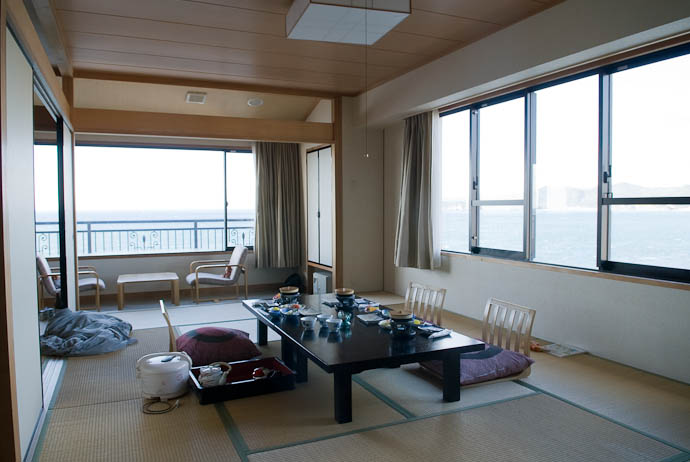
Nikon D200 + Nikkor 17-55mm f/2.8 @ 17 mm — 1/80 sec, f/4.5, ISO 100 — map & image data — nearby photos
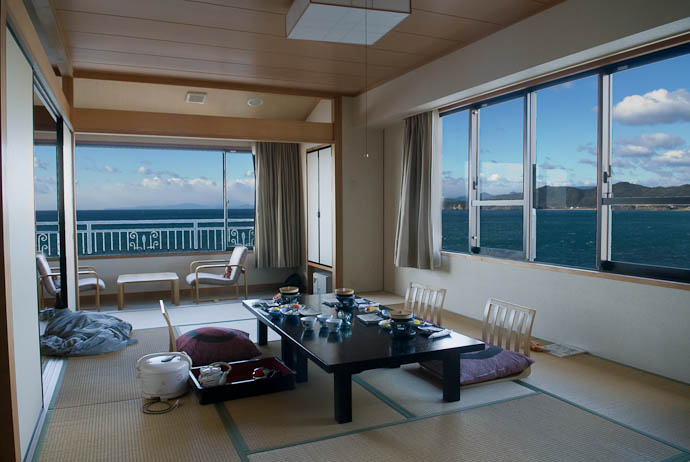
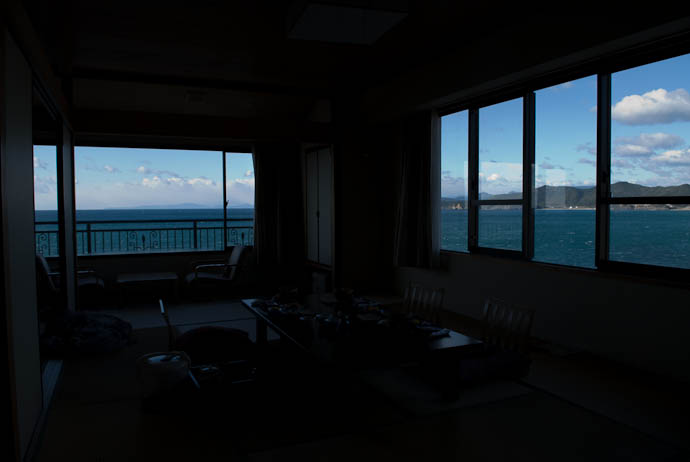
Nikon D200 + Nikkor 17-55mm f/2.8 @ 17 mm — 1/160 sec, f/6.3, ISO 100 — map & image data — nearby photos
I've got to admit up front that there are a few problems with my selection of source photos, and how I processed them. I didn't use a tripod when I took them, so the photos don't match up perfectly, and I used a different aperture (and likely a different focus) with each, which can cause further image-mismatch distortion. As for processing, I did it by hand in Photoshop, quickly and roughly, so some of the transitions are certainly harsher than they need to be.
Still, those are only small details compared the biggest problem, and that's our brain: in the HDR Combination above, the inside wall is actually brighter than the outside sea – something our brain just knows makes no sense.
The root problem with HDR is that even though, theoretically, it is able to bring to bear a wider range of detail, that detail still ends up being shoehorned back into the same “low dynamic range” of our current image/display technology.
In the “blown out” versions used in my two HDRs above, both the lanterns (of the first) and the outside sky (of the second) are encoded as “pure white”, which means that both appear – as far as our image/display technology is concerned – to be of equal brightness. Of course, that's silly because they're not of equal brightness: the sky is certainly thousands of times brighter than the lanterns, and were they to be placed in a scene together, the lanterns would be so relatively dark as to appear to be unlit.
So, if I wanted to fix the disconnect, I'd have to encode the photo so that the sky was brighter or the lantern was darker. Well, the sky is already encoded as bright as possible (“pure white”), so that means that I would have no choice but to dim the appearance of the lanterns considerably. That squeezes out detail as the whole lantern is moved toward blackness. It's closer to reality, but it's just the opposite of HDR.
Another approach would be to make the lantern dimmer, but less dim than it really should be, in the hopes of preserving some of its detail. We then run into the problem of how bright it becomes compared to other things in the scene, in the same way as the wall compared oddly to the outside sea. Considering that scene, if we added the lantern but dimmed it only half as much as reality would dictate, it may well appear reasonably natural when compared to the sky, but it would end up appearing brighter than other objects in the room that we know are brighter than it. So, then, begins the cat-herding exercise of trying to adjust relative brightnesses in such a way that we preserve local detail while at the same time avoiding the global disconnect for our brain.
“Preserve local detail” means that any one object or area takes up a good, meaty chunk of contrast, that is, of the total black-to-white range of brightnesses an image can contain. This is fine when you have everything in a similar brightness range, but when you have wildly differing brightnesses, their expanded ranges can't fit into the whole without overlapping. “Overlapping” is just the opposite of “wildly differing”, and hence our problem. In the end, you just can't fit 10 gallons of photons into a half-gallon bucket.
Sometimes the overlapping can be managed carefully, such as I did in the lantern photo, but it's questionable whether that kind of minimal treatment is really “HDR”. This road sunset is a better example of careful, prudent HDR. The room at the seaside ryokan above, and this lake scene are a bit more iffy, but most people's idea of HDR are wildly unrealistic, “gimmicky” scenes like this beach and this car.
The Fundamental Problem
The fundamental problem is that display technology has an extremely limited dynamic range. Your computer monitor can not show anything blacker than what you see when you turn it off, and it can't show anything brighter than what you see in this box: . Whether it's an overexposed firefly or the molten face of the sun, it comes out the same: . There's something wrong with that.
Frankly, until looking at a photo of the sun is as dangerous as actually looking at the sun, HDR will remain hobbled in the “reality” department.
Ouch.
Those are harsh words, yet, at the start of this post I used complimentary phrases like amazing, stunning, impactful, and eye-popping to describe HDR images. This apparent discrepancy in my thinking can be resolved by understanding the difference between “image” and “photograph”.
I sense that many who employ HDR do so feeling that it's a way to advance deeper in photography, to make an end-run around technological limitations and unleash the true potential of their camera. There are occasional exceptions, but generally, this turns out to be pure folly.
HDR as an Artistic Technique
I don't think HDR is a photographic technique, but on the other hand, I do think that it can be a wonderful artistic technique. The difference may just be semantics to some, but I think it's important to keep the proper frame of mind.
In the “artistic technique” frame of mind, HDR is in the same camp as numerous other image-processing techniques that use a photograph as their source. As one example of a “cousin of HDR”, here's a “painting” I made from a photo with Corel's Painter Essentials 3:
A closer cousin might be the “Dave Hill look” I applied to a photo in a recent post:
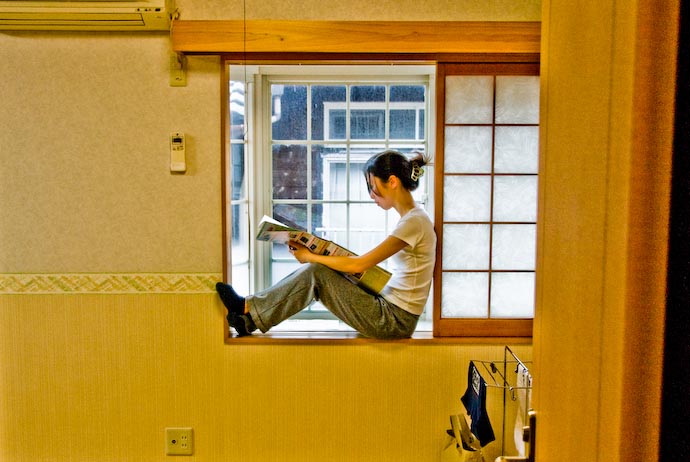
Nikon D200 + Nikkor 18-200mm f/3.5-5.6 VR @ 27 mm — 1/60 sec, f/4, ISO 640 — map & image data — nearby photos
I developed the technique to create the following image myself, using Photoshop's “Darken” blend mode...
Here's the result of applying way too much sharpening with Adobe Lightroom...
Here's another one done by twiddling the knobs in Lightroom...
Of course, there are untold other techniques, including numerous Photoshop filters that can also do amazing things.
The point is that none of these are “photos” anymore, just as most HDR images are generally not photos anymore. HDR can be great, but the result is almost always an unnatural, unearthly look. That look, like the results of any other artistic treatment, can be impactful and powerful and compelling, but it's a slippery slope to cliché and gimmicky. Be careful.
I'd been thinking of writing a post like this for quite some time, and finally decided to do it when GMSV (a witty and informative technology blog I read daily) referred to HDR as High Dynamic Range photography. I'd rather it be referred to as “imagery”, not “photography.”
Why I Don't Do HDR
After all is said and done, why don't I do HDR? Well, I'd love to if I had the time, but there are so many things I still want to explore within the realm of photography that I just don't have time for that non-photographic tangent. If I did have that kind of time, I think I'd want to spend it exploring more what I might be able to accomplish with Corel Painter.
What do you think?
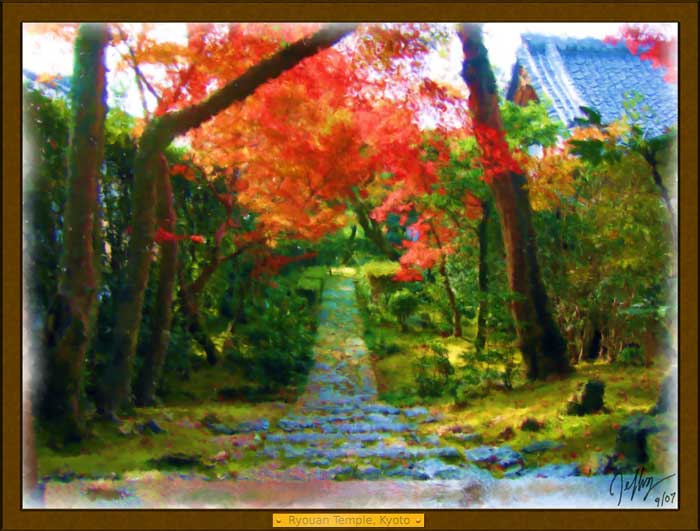
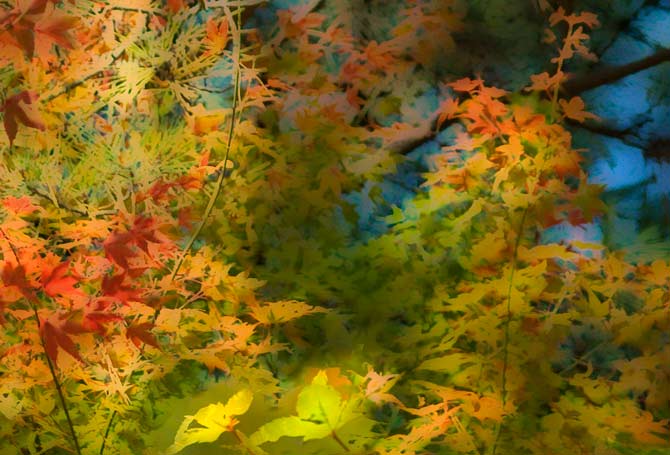
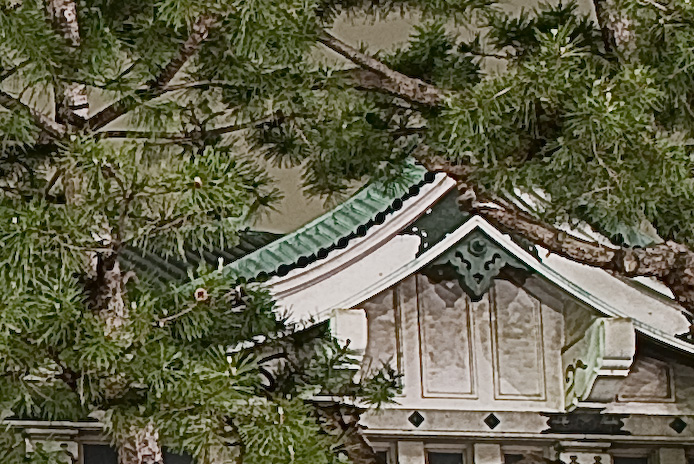
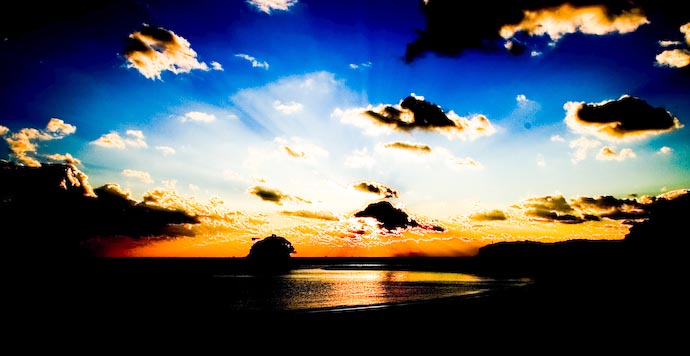
Jeffrey,
I think you hit the nail on the head when you mentioned that even though you can get proper exposure for everything using HDR, our brains also know that it doesn’t make sense in most cases.
Still, I think there are times when HDR can be used at very low strength to truly improve a photograph, and stay within the realm of what our brains see as normal. For instance, blending the final HDR result, which is hyperreal, with the original photo to achieve a middle ground can work better.
Flash can do the same thing as HDR, to some extent- Especially in the case of your seaside ryokan interior. The interior can be lit to a level that balances it with the outside view. Whether it looks “realistic” or not is another matter.
I think the real question you are starting to hit with this post is “what is art” vs “what is photography” and “how are these two the same?” and that is some highly debated and dangerous ground, indeed.
This is amazing post and amazing photos, and great analysis also.
I love photography myself, and only uncovered your blog fairly recently, unfortunately.
Anyhow, to the point, I think without a doubt the current state of Camera (especially digital) technology has very limited dynamic range, which is far smaller than the human eye.
What I’d like to see is a simple HDR switch on Digital Cameras, to force it to take 2-3 photos in fast sequence (with different exposures of course) and perform HDR algorithm in-camera. Anyone heard of that happening yet?
just an occasional visitor to your site here. I agree 100% about the idea of what HDR is. I never knew there was an arugment between it being a photography technique and it being an artistic technique. I personally love the look for HDRs. Especially if done right and not overdone with extreme tone mapping.
I always accept it as an interesting way to change a photo. Overdone it looks almost like a painting. And sometimes, that’s the effect you’re trying to set and it’s great.
But for photography puritans and even those on the middle ground, I would have to say HDR is definitely artistic. Our eyes, just do not see images that way.
Probably, photography might be the art of “capturing a snapshot of a scene”, such that it matches the perception of a human eye. If the limitations posed by “the sensor technology of the present days”, can be overcome by using HDR, we might see “photos or images” that are more real world centric rather can camera centric. I like the idea of Adi’s HDR button in the cameras. Better “sensor technology” might help.
Jeffrey
A very interesting post, perhaps provocative to HDR enthusiasts! I have the impression that HDR is a bit of a fashionable fad at the moment, to judge by the frequency of mention on the web.
Your post was opportune, since I was only yesterday trying HDR on a few church interior shots I took last week. I think my conclusions are very much like Jon’s: in some circumstances, done with a very light touch, the results can more closely approximate the subjective impression of the memory of a place.
I also agree with Jon that flash can similarly give disturbingly artificial results, for example with macro shots of natural subjects taken in the wild. Indeed, isn’t flash in effect another method of HDR? I think it is quite heartening that our brains do somehow recognise the artificiality of some HDR processing. I’m not sure I’d go so far as to say the results (of HDR or flash) are images but not photographs, but I suppose the dividing line is both vague and personal.
Adi’s idea of in-camera HDR processing alarms me, sorry, since I can imagine it being used far too often by some – the slippery slope referred to in the post. But I see nothing wrong in using exposure bracketing, an option on most cameras, to provide images for possible use in gentle HDR processing. As long as HDR requires some effort, it is likely to be used more selectively, rather than as a cure-all.
As for art vs photography, that is surely always going to be a matter of opinion: I am not sure that it really matters, provided that the image satisfies the photographer and hopefully, at least some of its viewers. I suppose the big thing about digital photography, especially, is that we can all play around with images to our heart’s content and, maybe, some of the results will be technically exciting photographs, others artistically satisfying, and some, just plain fun.
I hope your post stimulates many more comments!
A short update/clarification is in order at this point….
An on-camera “HDR” button, or multiple bracketed exposures, or more dynamic range to the sensor… these are not the answers to the biggest problem. The problem is that image-encoding and image-display technology don’t allow for a lot of dynamic range, and they don’t allow absolute brightness to be encoded. Things that increases the range and detail of the source dynamic range simply means that there’s more to throw away when its shoehorned into an image file, displayed on a screen, or printed on paper. Anyone shooting in raw already has more dynamic range available to them then someone shooting JPG with the same camera (indeed, mild HRD can be done with two different renderings from the same raw file).
To be clear, when I say “more to throw away”, I don’t mean to imply that a skilled/lucky artist can’t shift things around such that they have more control about what gets thrown away…. that’s what HDR – subtle and realistic, or gimickey and over the top – is all about.
By the way, other than the title of the post, I don’t think I wrote anything that’s particularly provocative. Thought provoking, I hope, but not provocative.
—Jeffrey
I was very interested into HDR but, after having obtained very disappointing results, my enthusiasm is cooling down. However, I think that sometimes HDR could render a boring picture a bit more interesting…
Of course, bracketed exposures or whatever are not a real answer to the problem but, as others have said, their use offers the possibility of enhancing, and perhaps improving, a photograph, in much the same way that tweaking exposure or white balance does. But as you say in your update, it is to some extent a destructive process and so, not one to be undertaken willy-nilly. I certainly do not see myself using HDR often, if at all, but I found it an interesting technique to tinker with.
Just to reassemble your split hair:
I think provocative and (thought-)provoking, having the same derivation, also have the same meaning – to instigate or stimulate a reaction or response (which you have!) – nothing innately negative about that. It is unfortunate and illogical that the former is sometimes used only in a pejorative sense.
So glad to see you back, Peter. I’d posted a number of foliage-heavy posts in hopes of hearing from you, but it took HDR to illicit a response :-). I expect that my mom will call you out on the provactive vs. thought-provoding issue, but to my American understanding, they have quite different meanings. The dictionary widget on my (American) MacBook agrees with me. Perhaps it’s one of those “separated by a common language” things? —Jeffrey
Jon and Peter’s comments about the use of flash bring up a good point. The brightness of the wall in the ryokan interior example doesn’t bother me, because interior lights can make this happen. At dusk, for example, the interior wall may indeed look brighter than the exterior scene.
So while I fundamentally agree with your position on HDR, I don’t think that particular example is a good illustration of it. When flash is used in a way that mimics something we see often (such as interior lights), it can looks natural to us.
I see in HDR a natural evolution of photography from Black and White over Color to get more information from the real world. There are still the limitations of print and screens, but in case of the latter, i hope that screens with a higher dynamic device will be affordable in the future. Even now you can get such screens, if you have some 10,000$ loose in your pocket. Since then you need sometimes extreme tonemapping to map all the information of the picture fitting the maximum dynamic range of the output media. Remember there are differences between paper and screen. Even in raw processing you map the higher dynamic range to a LDR (low dynamic range) image.
Perhaps , the people in the thirties of the last century have also ribbed their eyes, when they saw the first real color photography. HDR might be a question of custom.
It’s that “natural evolution” notion that I hoped to argue against in my post. Even if you spend $10,000 on a monitor, it still shows an overexposed firefly at exactly the same brightness as a telephoto zoom of the sun, the latter much too dim and the former much too bright. There’s a fundamental limitation to current image-encoding and image-display technology that slams the door shut on the whole “evolution in photography” thing. I don’t mean to imply that HDR is without value, but until there’s a radical change in visualization technology, HDR remains a minor (but valuable) image-cleanup or artistic-interpretation technique. —Jeffrey
I’m going to go out on a limb by being so blunt: photography is not “art”; it is more correctly a “craft”. This is not to say it requires no imagination, creativity, nor skill — quite the contrary. But in the end, the proper application of photography does not create anything new, but merely attempts to faithfully duplicate what the Mark 1 Eyeball perceived directly from the source. Any application beyond faithful rendering is where the “art” comes in.
Most HDR is firmly planted in the “art” category, IMHO.
Your summary seems completely reasonable to me. I’d only modify the last bit slightly, to suggest that there are thin, wispy tentacles of HDR that do venture into “photography” – the few cases where it really is used to get around current technical limitations – such as I did in the lanterns shot at the top of the post. —Jeffrey
Well, (Ahem!) in my opinion, I believe Jeff and Peter are both right to a point. “Provacative” is of course from ” Provoke ..to incline to anger.” Perhaps “Evoke..to elicit or draw forth” was the response Jeff hoped to achieve. But since I havn’t the slightest comprehension of the subject of “HDR”, I can’t really discern what he means by any of it. I’ll leave that to those who do. (I just read these posts looking for stuff about my Grandson Anthony) It was just nice to see Peter here again. Hi, Peter, don’t be such a stranger.
Hello and thank you, Grandma Friedl, for a diplomatic respons ! I guess I should have more regard for common usage. And yes, Jeffrey, ‘separated by a common language’ sums it up.
I’m not really such a stranger – I visit pretty much every day, but am shy of commenting on every post, though I enjoy all, be they plants, photography, family or just life in Japan !
I’d put light use of HDR in the photography category, because darkroom processing has always been a part of photography, and can be used to pull different levels out of different portions of film.
My problem with HDR is that too many people, particularly tech geeks, focus on it instead of basic traditional photographic techniques for handling lighting, color, and timing. I’ve even heard people say things like “wow, that’s a nice HDR!”.
[I unfortunately also fall into this bin of tech geeks who know a lot more about camera equipment than photography. On that note, i’ll also say that the latest and greatest of DSLRs has a higher dynamic range than the human eye, but lacks the brain for adjusting the exposure on the fly]
Display technology is limited, and print technology is limited in different ways, but a good photograph looks good on both.
You should read The HDRI Handbook, it is one of the best technical books I have read for some time.
Well I agree with you on the parts that it becomes less about photography and more about imaging and processing but the thing is, think about what a Lightroom used to be in a sense, you’d sit there and twiddle with it and have different development times and preferences and just in general messing with it was fun. So now we’re at the digital age with out film and the second part to Digital photography is Post – Processing. Some Photographers have enjoyed the development aspect to photography as well as taking the shot it self.
all in all don’t discredit HDR its just another field
I entirely agree with you about HDR, and I don’t really have time for it or Corel Painter – though I’d love to have time for both!
Interesting perspective. I’m late on the scene when it comes to HDR, as I only just starting hearing about it a month ago. The results are impressive pictures, but I totally agree with all you said here – especially regarding whether they are photography or art.
Often when I see an HDR image I have to look closely to determine whether it is a photograph, a very detailed drawing, or a 3D render. I’m a little bit wary of them for this reason, and I’d really rather people don’t misrepresent them as anything other than HDR images.
Hello, I 100% agree with Martin Tomes that you should all read The HDRI Handbook by Christian Bloch. It’s a fantastic learning experience.
Often when I see a HDR image it isn’t really a HDR image… That’s deep. It is most of the time some overly tone mapped exposure(s) pushed far beyond the range of what the data that was actually captured is capable of covering.
There are 2 major problems with the HDR argument.
One: What constitutes a HDR? How large of an EV range does an image need to have to be considered a High Dynamic Range image as opposed to a LDR?
And
Two: Your eye can see a much large range of light then the best digital or film camera can capture. So, when you look at a LDR image from your camera it isn’t actually anything like what your eyes see in terms of EV stops. So your feelings about the realism or accuracy of HDR images is based on what we have grown accustomed to expecting in LDR exposures.
A properly constructed HDR will more accurately depict what your eye sees then a traditional LDR photo. We just aren’t used to seeing images like that. For over a hundred years we have been stuck in a LDR world where we have to interpret what we see into a flattened contrasty, dumb down version of what is really visible to the human eye and we have taken that as the standard.
Now I’m not knocking standard photography. I personally like high contrast and silhouettes in my images. I do however think that most people are truly uninformed as to what a HDR image is and where it falls into the grand scheme of things.
Some Numbers:
Human Eye: 14 EV some even say it goes as high as 20EV but the standard agreeable figure is 14
HDR: as many as you want
FIlm & Digital Sensor: 6-8 EV
Print: 6 EV
I would like to know what cameras are taking higher EV stops then the human eye…. We should all have one if it exists.
Knowing your love of HDR Jeffrey 🙂 you might want to take a look at this site – Paris in HDR http://photoserge.com/portfolio/
Thank you for this awesome post. Not that it really changed my opinion, but it was nice to read pretty much my own thoughts written down so well.
I think the biggest problem with HDR is that, while sometimes it can make for better art (but not photos), it is NEVER with current technology a higher dynamic range. It baffles me how people think taking the shadows and making them mid-range, and then taking the highlights and making them mid-range as well would somehow result in a final image with higher dynamic range. Most (crappy) HDR images are pretty much just grey!
(Yes, I realize it’s a very old post, but I just had to say this ;))
Very interesting discussion, and still very relevant. I tend to think HDR is a natural evolution of photographic technique and I fully expect high end digital cameras to make multiple exposures (or maybe some new technique, 64 bit pixels or something) that will capture more of the light than is now possible. In a way I’m impatient for it to get here, along with much better display technology.
In the meantime, HDR techniques can be used to make a better photographic image, truer to what the photographer saw, or it can be used to manipulate a digital image to create something else, usually quite a bit on the surreal side. I would agree that the latter probably ought to be called something other than photographs, but from what I’ve read, I also think the “argument” between “realistic” and “painterly” photographers is a debate that has been going on since the early 1900’s.
Not all scenes are suitable for applying HDR techniques. I read a book (which has gone back to the library, so I can’t say if it’s the one cited above) which pointed out that there is no point in using HDR techniques when the EV range of a scene is entirely within the sensor’s range. On the other hand, as a photographer in the “realistic” school, I think an image like this one greatly benefited from having an HDR tool in my digital darkroom: http://redwoodtwig.deviantart.com/art/Afternoon-Light-160318996 The lighting and coloring and tones are much closer to what I saw, unlike any of the individual frames that I made, even though this HDR rendering has been dumbed down to 8 bits. I have found that subtle improvements through HDR techniques usually turn out better than tweaking with other digital darkroom tools like curves and layers.
But, if you look close, you will see that the images didn’t quite line up due to the light breeze. I now realize I just needed more patience — I should have waited there for the whole afternoon until I had enough time to make three exposures with no wind. There’s still no substitute for getting the exposures you want out of the camera.